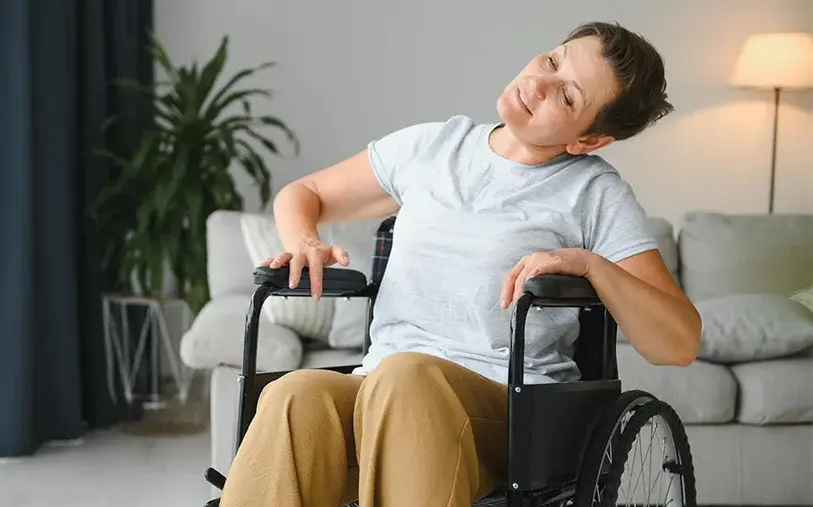Paralysis, also known as stroke, is a serious medical condition in which a part of the body loses its strength or becomes immobile. Recognizing the symptoms early and seeking treatment is crucial to preventing complications. In this article, we will discuss the symptoms of paralysis, its causes, and the available treatments.
Symptoms of Paralysis
1. Sudden Weakness or Numbness in the Limbs

One of the primary symptoms of paralysis is sudden weakness or numbness in the arms or legs, usually affecting one side of the body. This happens when a part of the brain doesn’t receive enough blood, causing disruptions in nerve function, which leads to weakness or numbness. If someone experiences sudden weakness or numbness, it should not be ignored, and medical help should be sought immediately.
2. Drooping of One Side of the Face

Facial drooping is another significant symptom of paralysis. During a stroke, one side of the face may droop, especially when trying to smile. This is due to damage or weakness in the facial nerves. If you notice sudden facial drooping or an uneven smile in someone, take it as a warning sign and seek medical attention without delay.
3. Difficulty Speaking
Difficulty in speaking is a common symptom of paralysis. The person may have trouble pronouncing words clearly, or they may be unable to speak at all. Sometimes, they may also find it hard to understand what others are saying. This occurs when the areas of the brain responsible for language are affected. If someone suddenly has trouble speaking or understanding, it could be a sign of a stroke.
4. Vision Problems
Vision issues are another symptom of paralysis. The person may experience blurred vision or even a complete loss of vision in one or both eyes. This happens when the part of the brain responsible for vision is affected by a lack of blood flow. If someone suddenly finds their vision impaired or starts seeing double, it could indicate a stroke, and immediate medical help is needed.
5. Severe Headache

A sudden, severe headache with no apparent cause can also be a symptom of paralysis. This might occur due to a brain hemorrhage or a blocked blood vessel. If someone experiences a sudden headache accompanied by nausea, vomiting, or confusion, they should see a doctor immediately.
6. Loss of Balance or Coordination
Paralysis can also lead to difficulty walking or maintaining balance. If the part of the brain that controls coordination and balance is affected, a person may have trouble walking or feel dizzy. If someone suddenly starts losing their balance or feels unsteady without any obvious reason, it could be a sign of paralysis.
Causes of Paralysis
1. Blockage of Blood Flow

Paralysis often occurs due to a blockage in the blood flow to the brain. This blockage is usually caused by a blood clot that prevents oxygen and nutrients from reaching the brain, leading to damage in the affected area.
2. Brain Hemorrhage

A brain hemorrhage is another cause of paralysis. This happens when a blood vessel in the brain ruptures and causes bleeding. This can be due to high blood pressure or a head injury, which leads to pressure on the brain and results in paralysis.
3. Heart Conditions
Heart conditions such as irregular heartbeats, clots in the heart, or a heart attack can also affect the blood flow to the brain, increasing the risk of paralysis.
Treatment for Paralysis

- Medications
Treating paralysis quickly and effectively is vital. Doctors may prescribe clot-busting medications to improve blood flow. These medications should be given within hours of the onset of symptoms to minimize brain damage and improve recovery outcomes. - Surgery
In cases of severe brain hemorrhage or large blood clots, surgery may be required. Surgeons can repair the damaged blood vessel or remove the clot, allowing normal blood flow to resume and preventing further complications. - Physical Therapy
Physical therapy plays a crucial role in recovery after paralysis. Through various exercises, physical therapy helps strengthen muscles, restore movement, and improve mobility. It is essential for regaining independence and improving the quality of life after paralysis. - Speech Therapy
If paralysis affects a person’s ability to speak, speech therapy can be very beneficial. Speech therapists work to help individuals regain their speech abilities and improve communication skills, making it easier for them to express themselves.
Conclusion
The symptoms of paralysis such as sudden weakness, facial drooping, difficulty speaking, and severe headaches should never be ignored. Early recognition and prompt treatment can significantly reduce the impact of paralysis. Maintaining a healthy lifestyle, managing stress, and seeking timely medical attention can help prevent paralysis. If you or someone you know shows signs of paralysis, seek medical help immediately.
If you have any queries related to medical health, consult Subhash Goyal or his team members on this given no +91 99150 72372, +91 99150 99575, +918283060000





